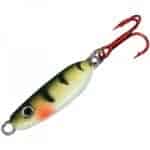
by Dave Csanda
Once crappies move deep to their usual winter haunts—down the edges of
dropoffs, and out across soft basin areas of 30-odd feet in depth—tiny
jigs tipped with softbaits become increasingly difficult to fish
effectively in deeper water.
Deep is a relative thing, however. Crappies don't like cavernous deep
basins; in lakes where 70 to 100 feet of water is available, they
typically ignore these sections in favor of lake areas where the basin
is considerably shallower. Thus, the portions of the lake bottoming out
at 30 or 40 feet tend to hold the most crappies. Leave the deeper stuff
to walleye fishermen.
In shallow soupbowl lakes with little structure, crappies routinely roam
and prowl their way across the open basin of the lake, settling
temporarily in areas with the best combination of food. On an extremely
shallow lake, a small, deep hole of the proper depth might draw most of
the crappies in the lake into a very limited area. Each lake is
different, so you need to evaluate what they offer to the fish, and plan
your fishing accordingly.
In early winter, crappies are often very bottom-oriented. By midwinter,
however, oxygen depletion begins taking place in the deepest portions of
the basins. Rather than leaving these areas completely, the fish
usually respond by rising higher in the water column, perhaps suspending
20 feet down over 30 feet of water, where oxygen is still suitable.
Crappies now patrol these levels in search of minnows, which likewise
roam, occasionally moving into the area beneath your hole.
As they do, these fish become clearly visible on your electronics,
indicating not only where to fish, but how deep to fish. You never want
to dangle your lures below the level of the fish, where they won't see
them. Rather, position your lures or baits at or slightly above the
fishes' eye level, where they can visually detect them, become
interested as they rise to examine your offering.
Crappie anglers fish for these suspended fish in several ways. The
first, and perhaps easiest method, is with a slip bobber rig, suspending
a live minnow at the fishes' level. Nick the minnow lightly below the
dorsal fin on a small #6 hook, and send it down. As the minnow dangles
and struggles, it tempts crappies to move in for the kill.
When a crappie inhales it, the resulting quiver imparted to the
bobber may be so subtle that you barely see it. At the slightest
suspicious motion of the bobber, set the hook!


Next up are various forms of jigging, which allow you to be far more
mobile and aggressive, covering water in search of active biters.
For sheer effectiveness, use slightly heavier baits than you'd use for
shallower bluegills; in effect, it's just too darned hard to fish tiny
softbaits on featherweight 1/64- or 1/80-ounce jigs in deep water.
Better choices are small spoons tipped with a minnow, minnow head or
live waxworm; compact jigging lures like a VMC Tungsten Chandelier;
1/32-ounce jigs tipped with live minnows; or #5 Jigging Rapalas, based
on the crappies' modestly deep location and aggressiveness.

The idea is to drop your lure down to the fish, then let it settle.
Jiggle it a bit, then let it settle again. The jiggle attracts them in
for a look, while the pause entices them to move in even closer,
hopefully to bite. With Jigging Raps, use a firmer upward stroke to pop
the lure upward, and then let it swim and settle below the hole. But the
principle is the same.
Using a good portable depth finder like a Humminbird ICE 45 or 55, your
lure appears on the screen as a small, brightly colored mark, and the
crappie a larger one. When the big mark moves up toward the smaller one,
and the two merge, you know the fish is barely inches away, eyeballing
your lure. Shortly thereafter, if the rod tip suddenly dips, indicating a
strike, set the hook.
If the fish doesn't strike within a few seconds, however, don't just let
the bait continue to dangle—especially if you see the fish begin to
lose interest and start dropping toward bottom. Instead, reel the bait
up a foot or two, jiggle it, and then pause again. Many times, the fish
will become re-interested and rise to follow. Sometimes, you need to do
this a few times to convince fish to bite. You'll notice that every time
you can get them to rise, they tend to become more active and
interested. The same trick works for bluegills, perch—even walleyes!







